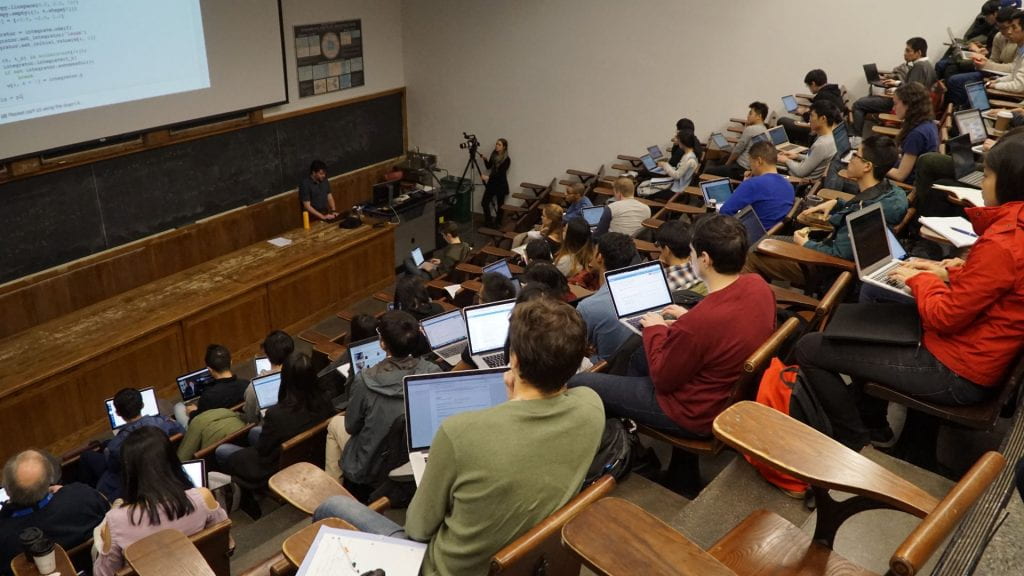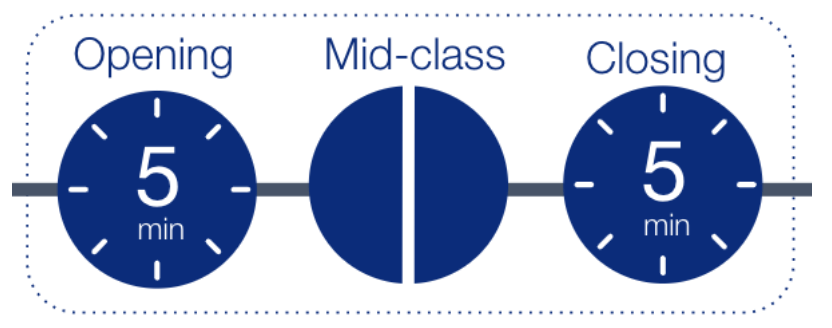Five Tips for Engaged Lecturing
 Traditional face-to-face lecture practices tend to be teacher-centered, focusing on what the instructor is doing and exposing students to course content in a limited way. There are ways to make lectures more effective and engaging, and move students from passively receiving information and ideas to actively engaging with the content – doing the learning and reflecting on what and how they are learning (Bonwell and Eison, 1991).
Traditional face-to-face lecture practices tend to be teacher-centered, focusing on what the instructor is doing and exposing students to course content in a limited way. There are ways to make lectures more effective and engaging, and move students from passively receiving information and ideas to actively engaging with the content – doing the learning and reflecting on what and how they are learning (Bonwell and Eison, 1991).
Designing a class session is about planning experiences that maximize student learning. The following five tips emphasize the importance of keeping the focus on the students’ experience and what they should be doing during a lecture.
The CTL is here to help!
Seeking additional support with planning your class sessions? Email CTLFaculty@columbia.edu to schedule a 1-1 consultation. For support with any of the Columbia tools discussed below, email ColumbiaCTL@columbia.edu or join our virtual office hours.
Interested in inviting the CTL to facilitate a session on this topic for your school, department, or program? Visit our Workshops To Go page for more information.
Cite this resource: Columbia Center for Teaching and Learning (2021). Five Tips for Engaged Lecturing. Columbia University. Retrieved [today’s date] from https://ctl.columbia.edu/resources-and-technology/resources/engaged-lecturing/
1. Begin with the end in mind.
What do you want your students to take away from the lecture?
- Ask yourself: what should students know, understand, and be able to do by the end of the lecture? The answers to these questions form the basis for your class session’s learning objectives.
- The learning objectives for each class session should align with those for the course (to learn more about course-level objectives, see the CTL’s Course Design Essentials video playlist and learn more about the CTL course design supports available).
- Communicate these learning objectives at the beginning of the lecture. Explain the purpose and relevance of the lecture topic (i.e., why should students learn this?).
2. Consider your learners and their learning.
Who are your learners? What prior knowledge and skills are they bringing to the lecture? What content needs to be explored more deeply during the class session?
As you select your content, consider your students and what prior knowledge they are bringing with them.
- Select lecture content based on the needs of your learners. Make lecture content relevant and meaningful. Model making connections.
- Build on or fill in the gaps between what students read, watched, or prepared prior to class.
- Provide an organizational structure that will help students organize and store what they learn during the class session.
Create a classroom environment that supports student learning regardless of prior knowledge, experience, comfort levels, and their learning spaces. See the Guide for Inclusive Teaching for practical strategies.
3. Break up a lecture (and take breaks).
How long is your class session? How might the time be broken into segments? When would you and your students benefit from a break?
Help students learn by not overloading their information processing capacity. Maintain their attention through lecture segments.
- Keep direct teaching brief (10-15 minute segments).
- Integrate short activities in-between segments for students to process their learning. Activities may include polling to engage and assess students, pausing for individual reflection, students working on case studies or problem sets in breakout rooms, etc. See Tip 4 for more ideas and links to resources.
- Schedule breaks for longer class sessions to allow students to process and refocus.
4. Pause for active learning.
What engagement and/or assessment activities would help your students achieve the articulated learning objectives for the session?
- Drawing on the science of learning (see Harrington and Zakrajsek, 2017; and Lang, 2016 for distillations of the findings into practical strategies), plan to have your students do the following:
- Share what they already know. This activates students’ prior knowledge on the lecture topic. A survey or poll questions can be used to conduct a prior knowledge check to gauge what students are bringing with them to class.
- Recall their learning. Invite students to make connections across lectures, readings, and/or homework; provide real world examples, and relate the subject to their experience and knowledge. Students can share in pairs, small groups, or during whole class discussion.
- Pause for reflection. Ask students to reflect on what and how they are learning. This builds their metacognitive skills. For instance, at the end of a class session, ask students to summarize the main points from the lecture rather than summarizing it yourself; or share their take-aways. Collect their summaries or take-aways to gauge what they are leaving the class session with and if the session objectives were met.
- Consider opportunities for students to meaningfully engage with course content and each other through paired or small group discussion (see CTL resource Learning Through Synchronous and Asynchronous Discussion).
For other engagement and assessment strategies, see Interactive Lecturing: A Handbook for College Faculty by Barkley and Major (2018); The K. Patricia Cross Academy’s Techniques Video Library; and the Learning Assessment Techniques: A Handbook for College Faculty by Barkley and Major (2016).
- For instructors concerned with not having enough time for student engagement given the pressure to “cover” the content, Lang (2016) suggests that these activities can take as little as five minutes at the beginning of class, mid-class, and at the end of the class session.
5. Plan for delivery.
What resources and instructional technologies will support the delivery of the class session, student engagement, and/or assessment?
- Diversify the modes of delivery/representation (see Universal Design for Learning framework for guidance); use visual aids to support your objectives and to maintain students’ attention.
- Integrate instructional tech to enhance in-person teaching and learning. Determine what Columbia-supported instructional technologies you will use and for what purpose. Explore tools such as polling with Poll Everywhere; or collaborative spaces in the Google Suite – Docs or Slides, for paperless in-person engagement opportunities.
- Make explicit to your learners how you will be using various technology tools and features during class sessions, and what you expect of your learners.
Planning Your Class Session
- What will you include in your session plans?
- What type of experiences will you provide for your students to support their learning?
- How might you enhance the in-person experience with instructional technology?
References and Resources
Barkley, E. F. and Major, C. H. (2018). Interactive Lecturing: A Handbook for College Faculty. Jossey-Bass.
Barkley, E. F., & Major, C. H. (2016). Learning assessment techniques : A handbook for college faculty. Jossey-Bass.
Bonwell, C.C. and Eison, J.A. (1991). Active Learning: Creating Excitement in the Classroom. ASHE-ERIC Higher Education Reports. Washington, DC: Associate for the Study of Higher Education.
Harrington, C. and Zakrajsek, T. D. (2017). Dynamic Lecturing: Research-Based Strategies to Enhance Lecture Effectiveness. Stylus Publishing.
Lang, J. M. (2016). Small Teaching: Everyday Lessons from the Science of Learning. Jossey-Bass.
Rice, G. T. (2017). Hitting Pause: 65 Lecture Breaks to Refresh and Reinforce Learning. Stylus Publishing.
The K. Patricia Cross Academy. Techniques Video Library. https://kpcrossacademy.org/videos/
The CTL researches and experiments.
The Columbia Center for Teaching and Learning provides an array of resources and tools for instructional activities.
